When selecting the right aggregate for resin-bound gravel on slopes, choose angular aggregates sized between 2-5mm for better grip and slip resistance. Ensure the aggregates are clean, washed, and dried to enhance resin adhesion. A well-graded mix that includes both fine and coarse particles is crucial to prevent voids. Additionally, implement effective drainage solutions to reduce water pooling. These factors are vital for stability and durability, and there’s plenty more to discover about optimising your aggregate selection.
Key Takeaways
- Choose angular aggregates between 2-5mm for better interlocking and slip resistance on slopes.
- Ensure aggregates are clean, dry, and free from dust to improve resin adhesion and longevity.
- Combine fine and coarse aggregates for better stability and load distribution.
- Steer clear of gap-graded aggregates to avoid voids; ensure there’s enough resin depth for larger aggregates.
- Use effective drainage solutions, such as channel drains, to manage runoff and prevent water pooling.
Understanding Aggregate Base Types
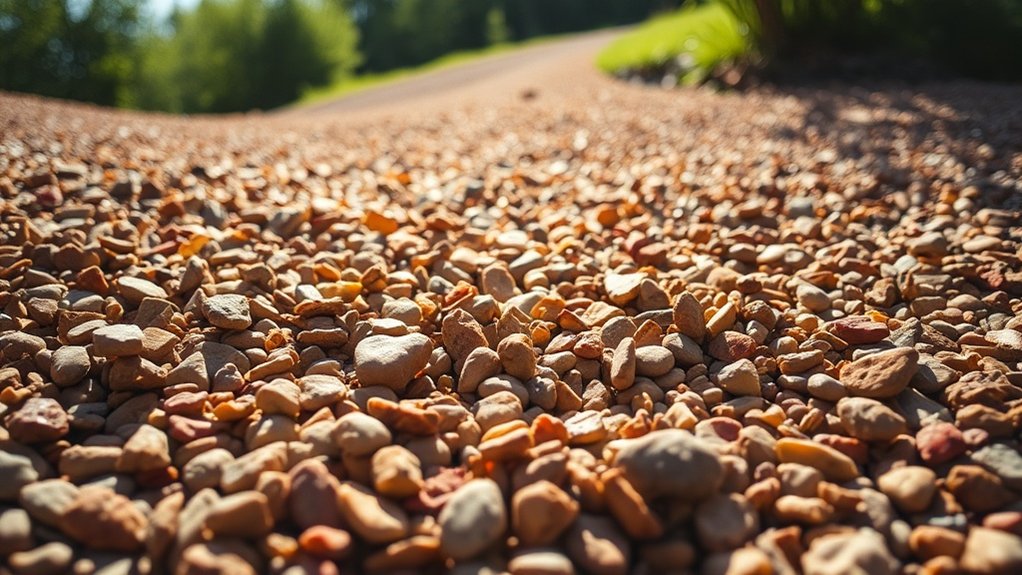
When choosing the right aggregate base for resin-bound gravel, it’s important to understand the different types available, as each affects stability. Concrete bases offer the best load-bearing capacity, making them ideal for areas with heavy traffic. Open-graded tarmacadam may not be as strong, but it allows for better drainage, making it suitable for Sustainable Drainage Systems (SuDS). MOT Type aggregates, especially Type 1 and Type 3, provide good compaction and stability, with Type 3 further improving drainage. Proper preparation of the sub-base is essential for longevity of resin-bound surfaces, ensuring they withstand the test of time. Advanced concrete-based permeable mixes offer tailored solutions, while grid systems are a cost-effective choice for lighter applications. Each option has its advantages, so consider your specific load and drainage requirements for the best results. Proper selection ensures effective drainage and prevents damage to the resin-bound surface over time.
Importance of Aggregate Preparation
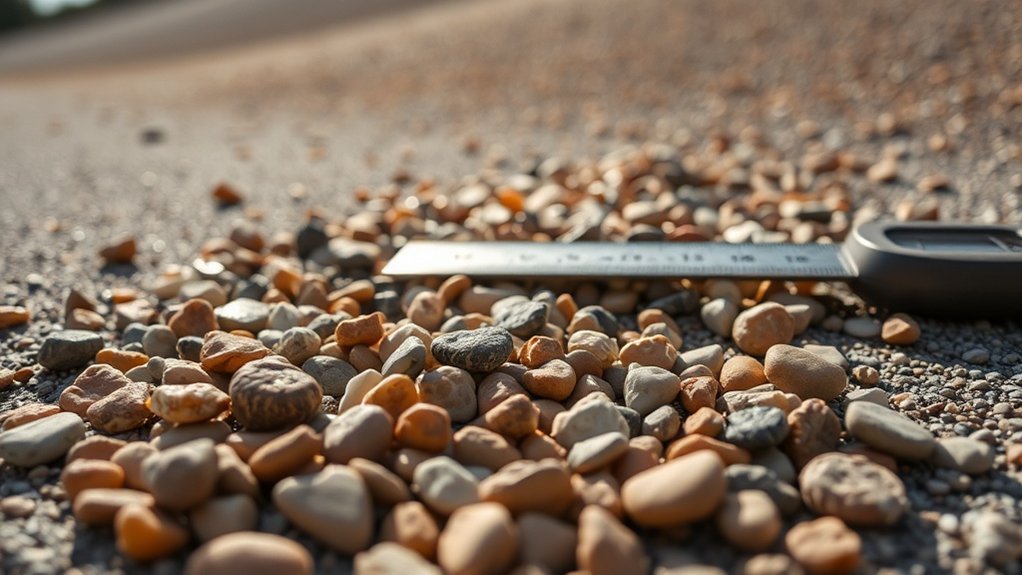
Aggregate preparation is crucial for the performance of resin-bound gravel installations. Clean and well-dried aggregates are key to achieving a strong bond between the resin and the aggregates. If the aggregates aren’t properly dried and cleaned, the resin may not adhere effectively, which can lead to failures.
- Well-dried aggregates improve resin adhesion.
- Dust-free aggregates reduce weak spots and surface flaws.
- Consistent aggregate sizes ensure better strength and stability. Properly prepared surfaces are essential for optimal installation results. Additionally, using washed and kiln-dried aggregates enhances the overall finish by reducing moisture and dust.
Taking the time to prepare aggregates properly can significantly enhance the durability and appearance of your installation.
Key Properties of Resin Binders
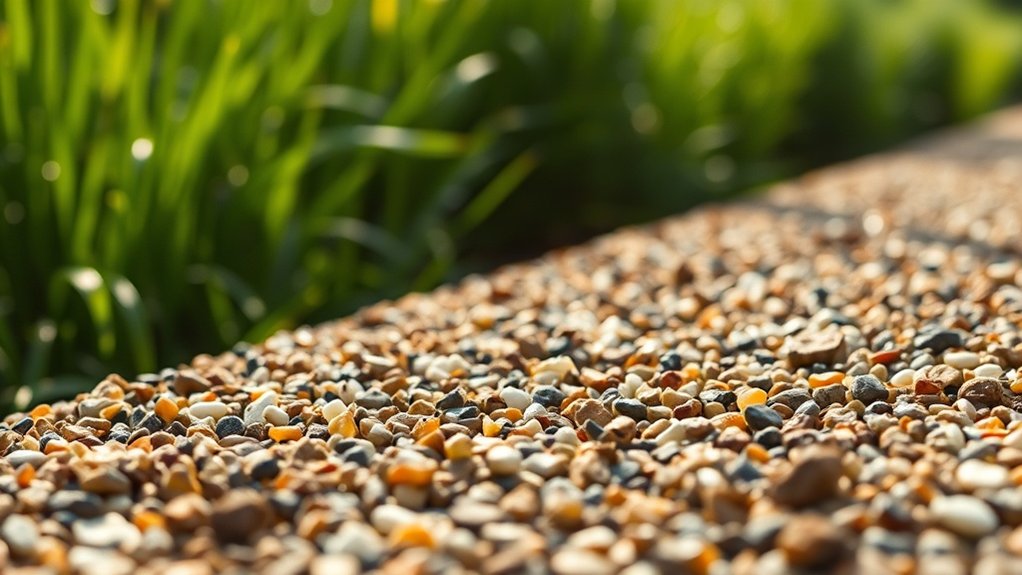
Understanding the key properties of resin binders is crucial for achieving optimal performance in resin-bound gravel applications. Various resin types, such as epoxy, phenolic, and acrylic, each have distinct properties that affect strength, flexibility, and durability. For example, phenolic resins excel in thermal stability and water resistance, making them ideal for outdoor settings. The binder’s mechanical integrity is enhanced by its chemical composition and cross-linking agents, ensuring longevity. Additionally, factors like viscosity and rheological characteristics, including viscoelasticity and thixotropy, play a significant role in application methods and stability. By carefully selecting the appropriate resin type based on these properties, you can maximise the effectiveness of your resin-bound gravel on slopes, resulting in a robust and reliable surface. Moreover, the use of biodegradable and non-toxic properties in binder resins aligns with sustainable innovation, further enhancing their appeal in environmentally conscious applications. Understanding resin-bound systems can significantly assist in choosing the right aggregate for your specific needs.
Ensuring Slip Resistance on Slopes
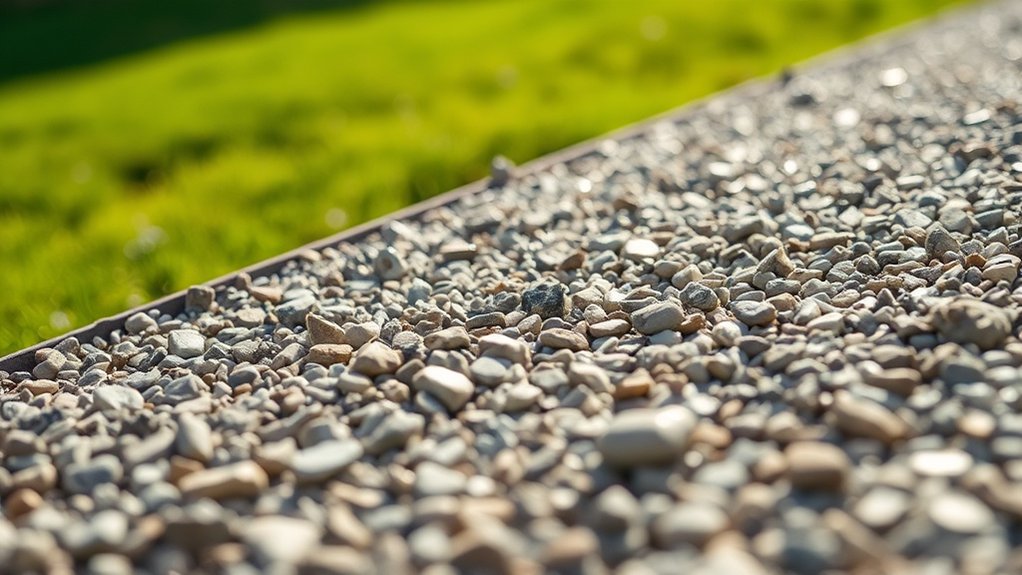
To ensure slip resistance on slopes, it’s essential to choose the right aggregates for a safe and durable surface. Angular aggregates, sized between 2-5mm, are preferred as they promote interlocking and improve grip.
Pay attention to surface roughness to enhance friction, especially in wet conditions.
- Opt for crushed glass aggregates, which provide high friction due to their sharp edges.
- Ensure aggregates allow for adequate permeability to prevent water pooling, reducing slip hazards.
- Regular maintenance and precise installation are key to achieving even aggregate distribution.
Drainage Solutions for Sloped Surfaces
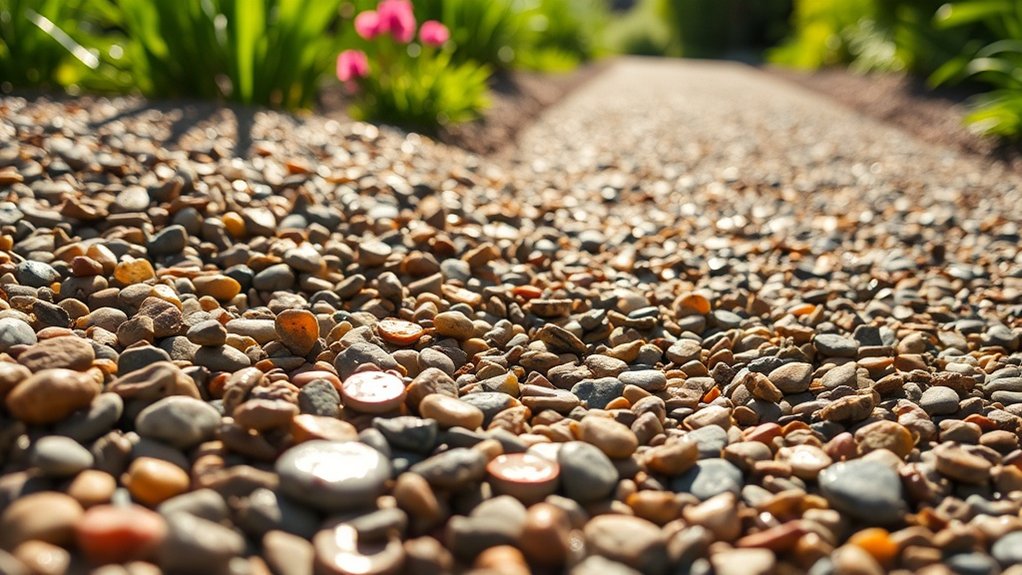
When managing drainage on sloped surfaces, it’s crucial to implement effective solutions to prevent water pooling and protect resin-bound gravel installations.
Using channel drains at the edges of slopes helps direct runoff safely to areas where water tends to accumulate. Soakaways can also be beneficial, allowing excess water to seep into well-draining soil and reducing the risk of saturation.
French drains, which consist of gravel-filled trenches or perforated pipes, efficiently redirect water while blending into the landscape.
Ensure that your slope maintains a gradient of at least 1-2% for natural runoff.
Proper base preparation is key.
Using permeable materials like type 1 MOT hardcore and rubber crumb sub-bases can significantly improve drainage.
This layered approach ensures that water flows effectively beneath the resin layer, protecting its integrity and preventing erosion.
Environmental Benefits of Permeable Systems
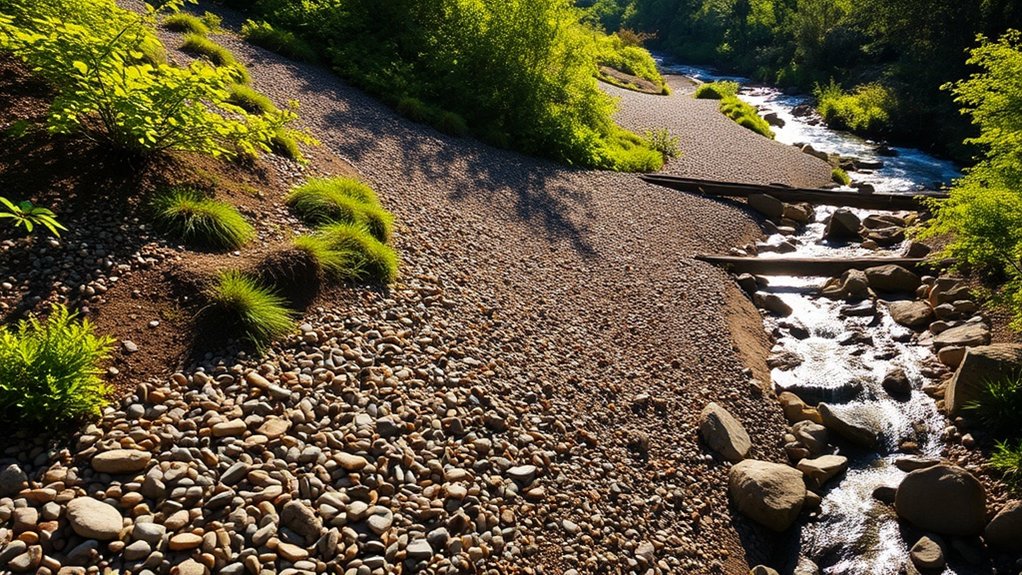
Effective drainage solutions not only safeguard resin-bound gravel installations but also promote environmental sustainability.
Permeable systems offer significant advantages, such as filtering pollutants and cooling urban areas. By allowing rainwater to soak in, these surfaces minimise runoff, reduce flood risks, and help replenish groundwater. They can filter out pollutants, achieving up to 97% removal of metals and significantly lowering nutrient loads, which in turn helps combat harmful algal blooms.
- Reduces sediment pollution, achieving a 94-99% decrease in total suspended solids.
- Promotes natural cooling through evaporation, alleviating urban heat island effects.
- Enhances urban biodiversity by improving soil health and supporting plant growth.
Incorporating permeable systems improves water quality and contributes to a healthier urban ecosystem.
Aesthetic Considerations in Aggregate Selection
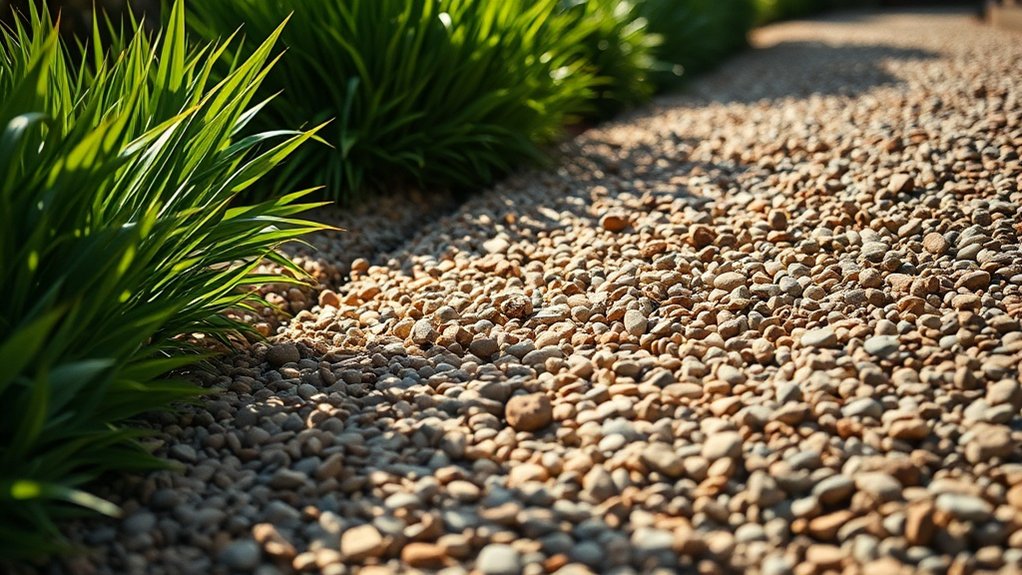
Selecting the right aggregate for resin-bound gravel is key not only for functionality but also for enhancing the aesthetics of outdoor spaces.
Consider colour harmony and contrast to add visual interest that complements your architecture. For traditional designs, natural tones work well, while bold colours suit contemporary settings.
Texture also plays a role; smooth aggregates provide a soft feel, whereas angular ones add a rugged touch.
It’s important to ensure your aggregate integrates well with the surrounding architecture, helping to highlight or complement building features.
Also, think about how aggregates reflect light—lighter options can brighten shaded areas, while darker choices absorb heat, affecting your outdoor experience throughout the year.
Tips for Optimal Aggregate Sizing and Grading
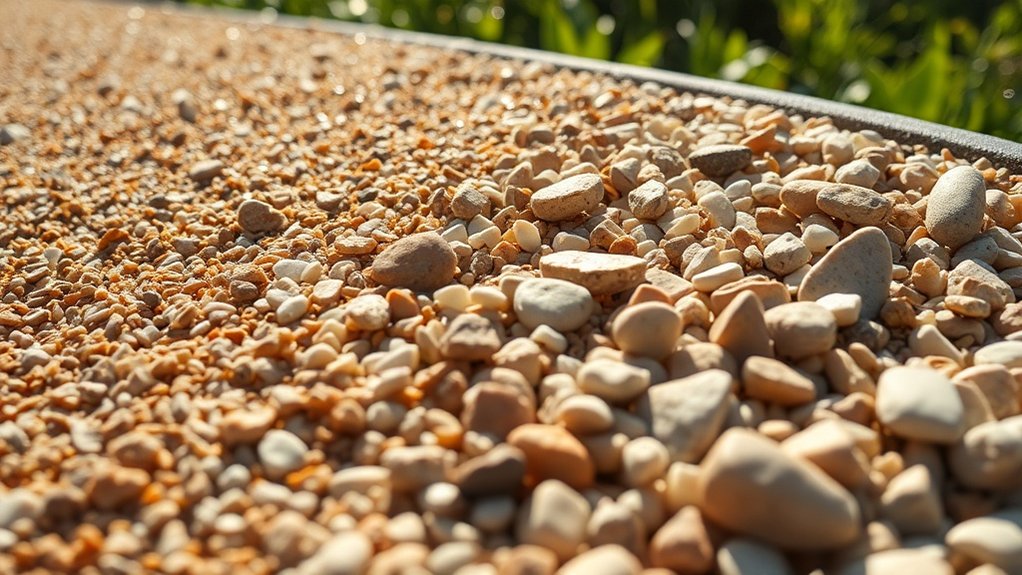
When choosing aggregate for resin-bound gravel, the right sizing and grading are crucial for stability and drainage.
Opt for a mix of angular aggregates within the recommended size range to enhance interlock and reduce voids. For instance, using a combination of 2-5mm and 5-10mm aggregates can improve the overall performance.
Also, pay attention to the texture of the aggregate; a rough surface can increase slip resistance and ensure effective drainage, especially on slopes.
Aggregate Size Importance
Optimising aggregate size is essential for the performance and durability of resin-bound gravel installations. The right aggregate size affects surface stability, drainage, and wear resistance.
- Aggregate sizes of 2-5mm enhance grip on slopes, minimising the risk of slips.
- Smaller aggregates (1-3mm) provide a smoother finish but may reduce mechanical interlock.
- Larger aggregates (6-10mm) require sufficient resin depth to maintain strength and stability.
Choosing the correct aggregate size not only aids in effective resin application but also helps prevent issues like cracking and surface failure.
Consistency in aggregate sizing is crucial for even wear and long-term performance on slopes. Keep these factors in mind to ensure a strong and reliable resin-bound gravel outcome.
Grading for Stability
Achieving stability in resin-bound gravel installations relies on the careful grading and sizing of aggregates.
It’s essential to use effective grading techniques to ensure a well-balanced mix of fine and coarse particles for optimal aggregate performance. A continuous grading curve improves compaction and load distribution, while avoiding gap-graded aggregates that can create voids and lead to instability.
Choose angular aggregates for better mechanical interlock and increased surface friction, both of which are crucial for maintaining slope stability.
Limit flaky or elongated particles to ensure strength. Additionally, achieving maximum dry density through proper compaction helps reduce displacement and enhances bonding with resin.
This focused approach to grading not only strengthens the structure but also helps prevent erosion and soil migration on slopes.
Texture and Drainage
How do texture and drainage work together to enhance the effectiveness of resin-bound gravel? The right aggregate texture not only boosts grip but also improves drainage. Here are some key points to consider:
- Angular aggregates (2-5mm) interlock more effectively, which enhances surface stability and anti-slip properties, particularly on slopes.
- A well-graded mix of aggregates strikes a balance between permeability and texture, helping to prevent water pooling and ensuring surface cohesion.
- Kiln-dried, washed aggregates reduce the presence of fines, which aids drainage and improves resin adhesion, critical for long-lasting performance.
Frequently Asked Questions
How Do Weather Conditions Affect Aggregate Selection for Slopes?
Weather conditions significantly influence aggregate selection for slopes. It’s essential to choose materials with robust resistance to weathering, particularly to withstand freeze-thaw cycles, which can lead to structural damage. Consider factors like humidity and temperature fluctuations, ensuring that aggregates remain stable and perform well despite changing environmental conditions. For example, in regions with heavy rainfall, opt for aggregates that drain well to prevent water pooling and erosion.
Can Recycled Aggregates Be Used for Resin-Bound Gravel Applications?
Yes, recycled aggregates can be used for resin-bound gravel applications. They provide environmental advantages by minimising waste and reducing the need for new materials. Not only do they enhance the visual appeal of your project, but they also contribute to sustainable building practices. Importantly, these aggregates meet the necessary technical standards for performance and durability.
What Are the Costs Associated With Different Aggregate Types?
Aggregate pricing can differ significantly depending on the type and source. For instance, bespoke blends tend to be more expensive, whereas aggregates sourced locally are generally more affordable. This variation can greatly affect your project budget and material choices. For example, using locally sourced gravel for a driveway may save you money compared to opting for a custom mix designed for aesthetics.
How Do Local Regulations Impact Aggregate Choices for Slopes?
Local regulations significantly affect your choice of aggregates, particularly regarding slope stability. It’s essential to select aggregates that meet these guidelines, ensuring effective drainage and safety, whilst also considering the visual appeal of the sloped areas. For example, using gritstone or limestone can enhance both stability and appearance, making them popular choices for landscaping in hilly regions.
What Maintenance Is Required for Resin-Bound Surfaces on Slopes?
Routine surface cleaning is necessary to remove debris, and drainage systems should be inspected monthly. Regular assessments and prompt repairs are vital to maintaining resin-bound surfaces on slopes, ensuring they remain durable and visually appealing over time.
Conclusion
Choosing the right aggregate for resin-bound gravel on slopes is crucial for ensuring stability and durability. To make the best choice, consider the types of aggregates available, prepare the area properly, and think about factors such as slip resistance, drainage, and appearance. For example, using angular aggregates can improve grip, while rounded ones may not provide the same level of traction. Additionally, the right sizing and grading are vital for optimal performance. By following these straightforward guidelines, you can make informed decisions that enhance both the functionality and aesthetic appeal of your project.
